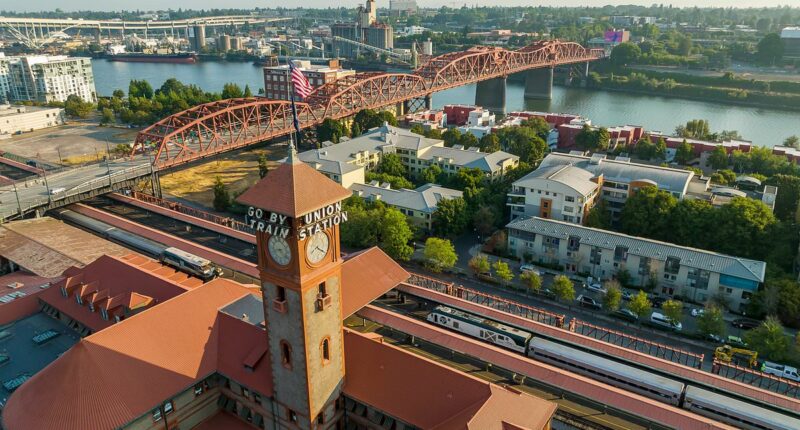Share this @internewscast.com
Portland’s Union Station has recently been recognized by National Geographic as one of the most beautiful train stations in the United States. However, the grandeur of this landmark is starkly contrasted by the bleak conditions surrounding it.
The city’s downtown has been consumed by homelessness, open-air drug use, and economic decline in recent years.
The station, inaugurated in 1896, stands as the oldest significant train hub on the West Coast. Designed in the Romanesque Revival style, it is easily identified by its 150-foot clock tower topped with the words ‘Go By Train,’ a neon sign that is now a local symbol.
Inside, visitors are greeted by the main hall’s high coffered ceilings adorned with floral medallions, walls and floors lined with marble, and wood-paneled benches reminiscent of the golden era of American rail travel.
Union Station was conceived as the centerpiece of Portland’s 19th-century push to transform itself from a waystation into a major destination.
In the 1870s, railroad magnate Henry Villard took control of the city’s rail operations, connecting Portland to the national rail network and establishing a transcontinental line that reached the Pacific Northwest.
Upon its delayed opening, the station was accompanied by the lavish Portland Hotel, quickly becoming a proud emblem of the city’s aspirations.
At its peak, Union Station was a bustling hub for four separate railways, funneling wealth and visitors into the city.
Even in modern times, the building continues to function as a lively transit hub, accommodating Amtrak passengers on long-haul routes such as the Coast Starlight and Empire Builder.

Portland’s Union Station, crowned by its iconic ‘Go By Train’ clock tower, was hailed by National Geographic as one of the most beautiful train stations in the US

Portland’s grandest landmark is surrounded by a downtown many residents now consider unsafe, plagued by crime, vagrancy and decay

Inside the station: marble walls, flower-shaped ceiling medallions and wooden pews recall the golden age of rail travel
It also houses Wilf’s, a restaurant and jazz club that has operated since 1975, offering classic steakhouse fare and nightly music.
The station’s historic architecture and cultural cachet earned it a spot on National Geographic’s list of eight ‘historic design marvels,’ alongside New York’s Grand Central and Washington D.C.’s Union Station.
But beyond its ornate halls lies a very different picture. Portland’s downtown has suffered a dramatic decline in recent years, with tent encampments, rampant drug use and vacant skyscrapers overshadowing even its most beautiful landmarks.

Union Station opened in 1896 and is considered the oldest major passenger terminal on the West Coast

Drug possession has been recriminalizing in Oregon after its lax policy led to soaring overdose rates and rampant homelessness across the state
Office vacancy rates reached 35 percent earlier this year – the highest among America’s 25 largest downtowns – while the city’s tallest tower, the U.S. Bancorp ‘Big Pink,’ is more than half empty and recently listed for sale at a fraction of its former value.
The downturn was accelerated by Oregon’s 2020 experiment with drug decriminalization, which reduced possession of heroin, fentanyl and methamphetamine to the level of a parking ticket.
What was meant as a progressive reform instead fueled an overdose crisis and entrenched open-air drug markets across the city.
By 2023, Oregon counted more than 20,000 homeless people, nearly two-thirds of them unsheltered, as overdose deaths surged.
The state has since reversed course, recriminalizing hard drug possession, but downtown Portland has struggled to recover.

Following decriminalization, overdoses soared as the state struggled to fund the enhanced treatment centers and public opinion soured on the policy

More than half of voters in Portland would still consider leaving the city if they could afford to, according to a poll commissioned by the Portland police union
Portland also whipsawed on policing. In June 2020, amid Black Lives Matter protests and calls to ‘defund the police,’ officials slashed millions from the force’s budget. A year later, faced with rising crime, homelessness and drug use, they increased the $230 million budget by $5.2 million.
Even so, disillusionment runs deep. A poll commissioned by the city’s police union found more than half of residents would leave if they could afford to.
Nearly two-thirds said Portland is ‘on the wrong track,’ and 68 percent believe the city is ‘losing what made it special.’

















